-
I had a pain in my knee and went to the hospital. I was told that I had Jumper's knee.
-
If you play volleyball, basketball, soccer, the high jump, or soccer and have a pain in front side of knee, it is possible to have Jumper's knee, also known as patellar tendinitis.
Jumper's knee is a condition in which the "patellar tendon", located just below the knee plate, becomes hypersensitive. It causes pain in various activities such as sports and even daily life.
Although the name has the word “jumper,” it does not necessarily occur only in person who plays jumping sports. It can also occur in long-distance runners such as marathon and other athletes.In some cases, Jumper's knee can be cured without any treatment, but unfortunately most cases, it takes a long time to heal. If the symptoms do not improve easily, it is recommended to visit a specialized medical institution.
-
Where does Jumper's knee hurt? What are the symptoms?
-
The medical term for Jumper's knee is patellar tendonitis or patellar tendinitis. The patellar tendon is located just below the knee plate, where it hits the ground when kneeling.
The symptoms are you feel pain when jumping, running, or climbing stairs.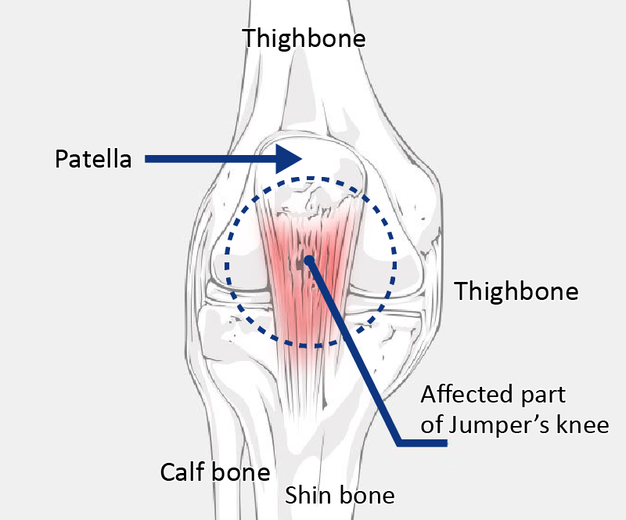
-
What is the reason causing Jumper's knee? Why it occurs?
-
It is believed that the cause of Jumper's knee, also known as patellar tendonitis, is "problem blood vessels" in the patellar tendon. The cause of the problem blood vessels is repetitive strain. When you jump and land, the patellar tendon is pulled. When strong strain is applied, small wounds occur in the tendon. This increases the blood vessels to cure the wounds. Usually, the wounds can be cured within 2 weeks and the increased blood vessels disappear. However, if you keep applying strain before curing the wounds, there will be new wounds and blood vessels increasing.
When blood vessels increase, there will always be nerves along with them and it causes pain. This unnecessary blood vessels are called problem blood vessels or moya-moya blood vessels in our clinic. Please refer to the following article if you are interested in moya-moya blood vessels.
-
How do you diagnose Jumper's knee?
-
We first check if you feel pain in the patellar tendon where just below of knee plate. We also check if the pain occurs when you jump, make a dash, or climb stairs. Jumper’s knee is strongly suspected, especially if there is tenderness under the knee plate when the knee is extended or bent.
Further imaging tests can confirm the diagnosis. Echocardiography is often used because it is easy and quick to diagnose.
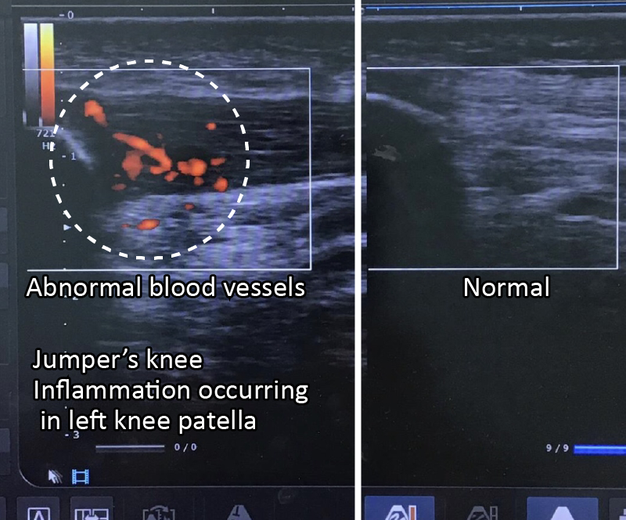
Here is an actual image of echocardiography. Compared to the picture on the right (normal), the tendon in the left picture (Jumper’s knee) is black and swollen. You can see that the red vascular signals are invading the swollen tendon.
Other imaging tests such as MRI are used to diagnose the problem as well.
-
I have a pain above the knee plate. Is this also Jumper's knee?
-
If you feel pain above the knee plate, it is possible to have a disease called patellofemoral ligamentitis. However, it is also a kind of Jumper’s knee.
The treatment for patellofemoral ligamentitis is almost identical to the treatment for another Jumper’s knee. If you are worried about your symptoms, please consult with a specialist.
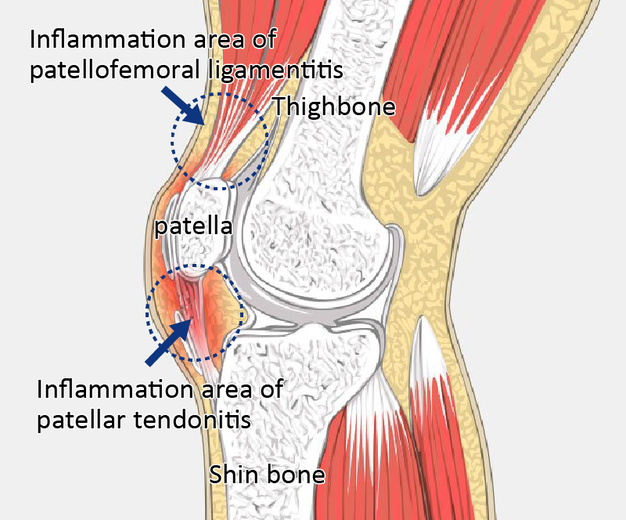
-
I hesitate to have an injection for Jumper's knee. Is it effective?
-
Depends on what kind of injection you are planning to have.
There is an injection called steroid heals inflammation, but we do not recommend it for Jumper’s knee. Because injecting steroid in tendon such as patellar tendon causes to weaken and at worst case it ruptures.
Another injection called hyaluronic acid does not weaken the tendon but is not very effective. In conclusion, we recommend not to take injections without any consideration. Please consult with a pain specialist doctor.
-
Is there any effective stretch for Jumper's knee?
-
Here are some effective stretches for Jumper’s knee.
If you feel pain right after training, it would be more effective to cool down first and do the below stretch.Stretch 1: Stretching the quadriceps muscle
Do this stretch while standing on one leg. It is easier to keep your balance if you use a desk or a pillar for support. Bend the knee you want to stretch gingerly so that the heel touches the buttocks. Hold the back of the bent leg with your hand and pull your hand to move the knee backward. The front side of your thigh will then become tense, and you should continue in this position for about 15 seconds.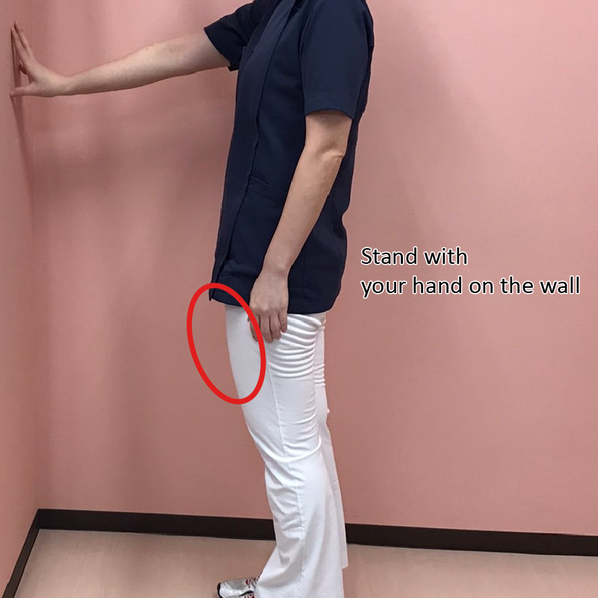
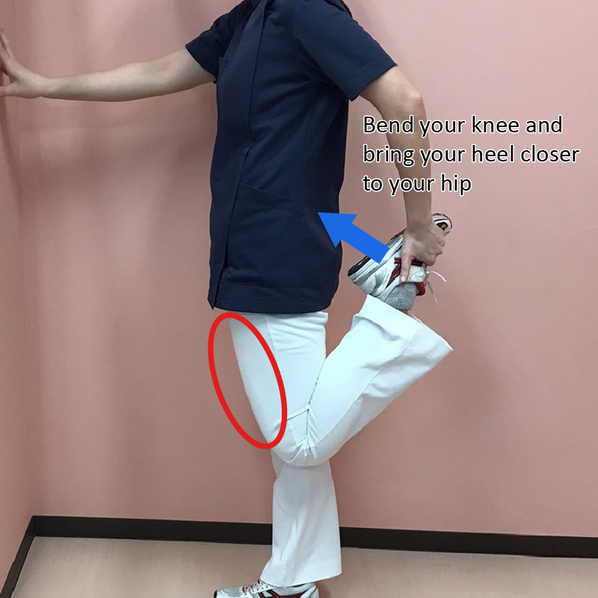
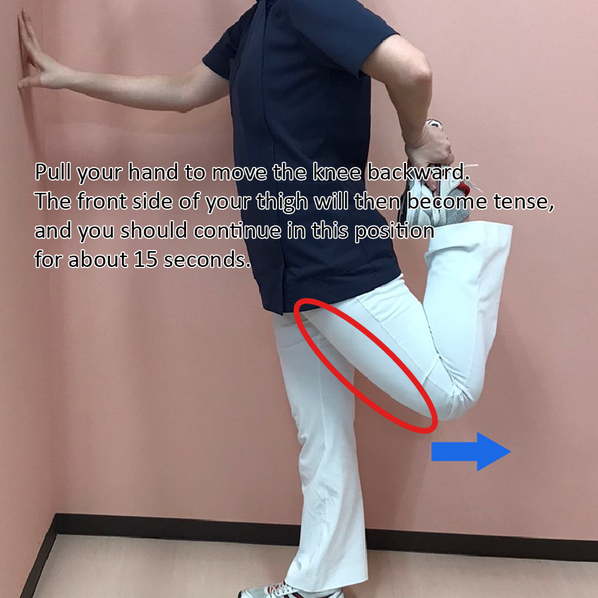
Stretch 2: Stretching the iliopsoas muscle
Lie face-down with raising your hands. Cross the leg you want to stretch behind and move it as far outward as possible, past the opposite leg. Extend the hand you want to stretch as far as possible. You will feel a stretching sensation in the iliopsoas muscle, which is on the stomach side of the trunk and hip joint and hold it there for 15 seconds.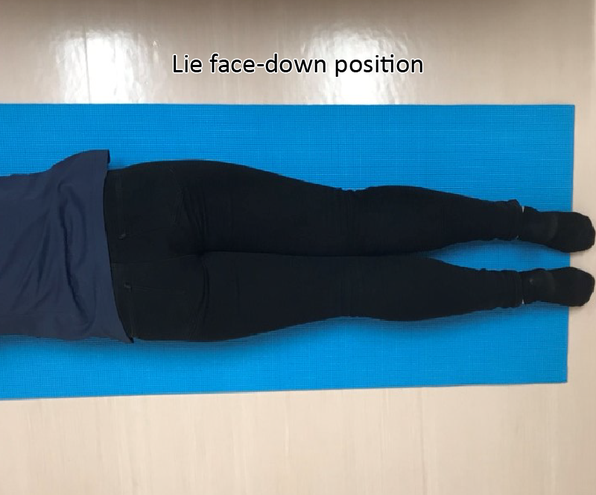
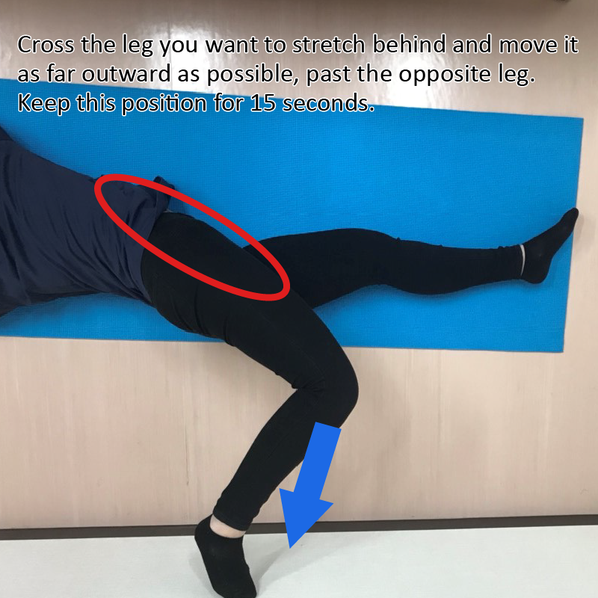
In addition to these stretches, other effective stretches are available for quadriceps and iliopsoas muscles. However, if you feel pain not only after training, but also in your daily life, stretching itself alone may not be enough to improve the pain. Please consider visiting a specialized medical institution.
-
Is there any way to prevent Jumper's knee?
-
The above stretches are also effective for prevention.
One of the causes of Jumper’s knee is “overuse,” as a preventive measure, the amount of practice should be reduced if you feel pain after training. If Jumper’s knee becomes severe, it can become a life- threatening injury. If the pain seems to be severe, we recommend you see a doctor and ask appropriate treatment.
-
Is there any effective taping or supporter for Jumper’s knee?
-
If your case is not so severe, it will heal in a few weeks. But if your case is severe, it will not heal easily.
If you find that your knee is not healing even though you stop practicing training and take a treatment, it may be because the treatment you chose is not properly approaching the cause of the pain. As mentioned in the previous article, the cause of Jumper’s knee pain is “problem blood vessels” and “increased nerves” around the problem blood vessels.
It cannot be improved unless you approach the cause of the pain properly. If you have pain for more than half a year, it sounds to be severe case already, please consult with a specialized medical institution.
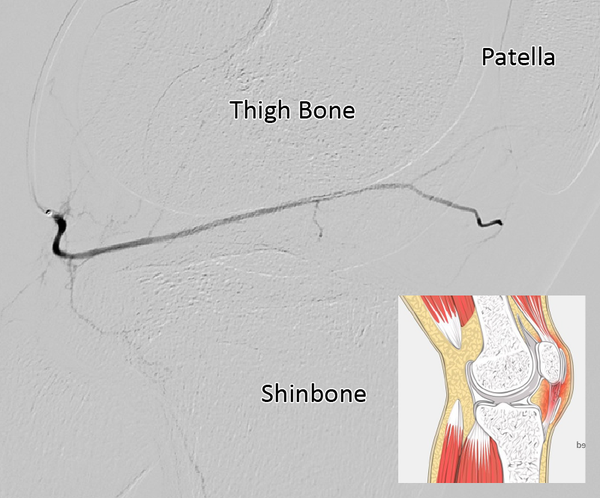
Normal Knee 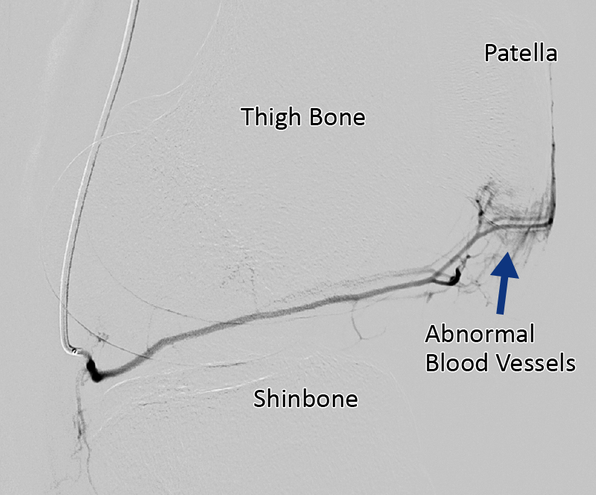
Jumper’s Knee
-
I have Jumper's knee and tried rehabilitation and injections, but it has not improved. Is it better to have surgery? What kind of further treatment is available?
-
If your case is severe and does not improve with injections, there is a new treatment called catheterization. This treatment approaches the problem blood vessels, the cause of Jumper’s knee, with the goal of a complete recovery. For further information, please refer to this article as well.
You also have an option of surgery, which removes a portion of the tendon where causes the pain. In this case, the original tissue is removed and replaced with a new tissue. However, the results are not very good. In addition, there may be residual pain and discomfort even after the surgery. It also requires hospitalization, so we do not strongly recommend it.
Author

-
-Dr. Yuji Okuno-
ฉันเริ่มต้นอาชีพในฐานะแพทย์รังสีวิทยาทางการแทรกแซง ซึ่งนำไปสู่การวิจัยเกี่ยวกับการสร้างหลอดเลือดผิดปกติในระหว่างการศึกษาปริญญาโท ในฐานะผู้เขียนหลัก ฉันได้เผยแพร่ผลการศึกษาที่เกี่ยวข้องกับยีนที่เกี่ยวข้องในวารสาร Nature Medicine ในปี 2012 จากงานวิจัยนี้ ฉันได้พัฒนาการรักษาด้วยการอุดหลอดเลือดแบบใหม่สำหรับโรคทางกล้ามเนื้อและกระดูกเรื้อรัง เช่น ข้อเข่าเสื่อมและไหล่แข็ง และเป็นคนแรกที่รายงานถึงความปลอดภัยและประสิทธิภาพของมัน แนวทางนี้กำลังได้รับการศึกษาระดับนานาชาติ
-Career-
2549-2552 นักศึกษาฝึกงาน, ภาควิชารังสีวิทยา, คลินิกา ET, โยโกฮาม่า, ญี่ปุ่น
2552-2555 นักวิจัย, ศูนย์วิจัยการแพทย์แบบบูรณาการ, มหาวิทยาลัยเคโอ, โตเกียว, ญี่ปุ่น
2555-2558 นักวิจัยคลินิก, ภาควิชารังสีวิทยาทางการแทรกแซง, โรงพยาบาลเอดะโงะ, โตเกียว, ญี่ปุ่น
2558-2560 ผู้อำนวยการ, ศูนย์แทรกแซงทางกระดูกและข้อ, โรงพยาบาลเอดะโงะ, โตเกียว, ญี่ปุ่น
2560- ปัจจุบัน ผู้อำนวยการสูงสุด, คลินิกโอกุโนะ, โตเกียว, ญี่ปุ่น
Latest posts
 Sep 12, 2025โรคเกาต์ FAQ
Sep 12, 2025โรคเกาต์ FAQ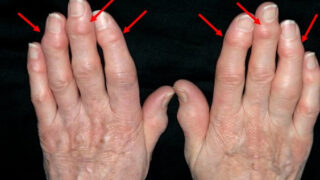 Sep 12, 2025Heberdens Nodes FAQ
Sep 12, 2025Heberdens Nodes FAQ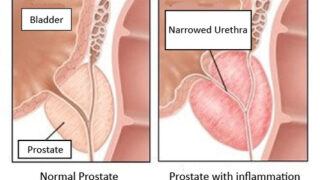 Feb 7, 2025Chronic prostatitis โรคต่อมลูกหมากอักเสบ
Feb 7, 2025Chronic prostatitis โรคต่อมลูกหมากอักเสบ Feb 7, 2025Frozen shoulder โรคไหล่ติด
Feb 7, 2025Frozen shoulder โรคไหล่ติด